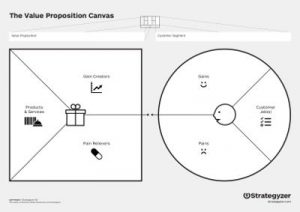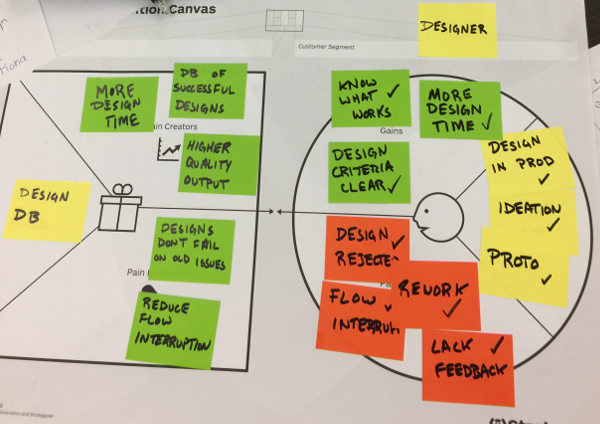Value Proposition Design Process
We’re going to introduce a process called Value Proposition Design. We use this to design a solution that fits your customer’s needs in a way that really connects with what they hope to accomplish. In this overview we’ll cover the VPD canvas and explain how it can be used to design a compelling value proposition. We’ll explain the importance of testing your assumptions. Finally, we’ll look at how this is particularly helpful for startups and organizations facing major strategic shifts.
Value Proposition Design Summary
- Profile a Customer Segment
- Uses Jobs-To-Be-Done Framework
- Customer-centric process
- Develop Product-Solution Fit by connecting to Customer Pains and Gains
- Provides a framework for market validation

Sections Of The Canvas
The canvas is broken into two perspectives to separate the Customer from the Product. Try to maintain each mindset separately as you work on the sections. Also, start from the customer’s perspective. You design a solution for a customer, you don’t design a customer for your solution.
Customer Jobs
Start filling the canvas by listing the jobs your customer wants to complete. The most important functional jobs, as well as social, and emotional jobs should be identified. Don’t stop at the most obvious, direct, or typical needs. Ask ‘Why?’ and dig deeper into the customer’s underlying needs.
Pains
Customer pains are things that annoy them, cause stress, exist as risks, or cause some other negative outcome as the customer tries to complete a job. Failure, potential losses, costs, inefficiency, and difficult processes are all pains. Our customer’s most important challenges and especially those tied to important jobs should be described in this section of the canvas.
Gains
This section documents the expected outcomes, important value-adds, or unexpected successes that the customer values. Great outcomes that are connected to important jobs are especially important to understand.

Product & Service
Thinking with your firm’s mindset now, identify the product bundle that is offered to the customer segment. If you are designing a completely new product complete this stage last. Be careful not to simply copy the customer jobs. Be honest about what you can offer.
Pain Relievers
Now we get to the heart of Product-Solution Fit. What aspect of the Product Bundle relieves one of the important customer pains that you identified previously? Are there other possibilities? Are you targeting a pain that is not important according to your earlier work? Is there a way to modify your proposition to improve the fit with the customer pains.
Gain Creators
Finally, the same process occurs with gain creators. How can you present an offer that provides a good experience and offers moments of delight to the customer? Do you currently include undesired features? How can you improve the fit? Explore the options at your disposal and use design iterations to create a fit that best improves the customer’s experience.
Problem-Solution Fit to Product-Market Fit
Validating Problem-Solution Fit
We want to know that our product will do well in the market, but at the moment all we have is a theory that we can solve our customer’s problems. You’ve imagined a possible solution to propose but now you need to test that offer within the market and mold it into a solution that the customer will adopt. We do this by iteratively building, measuring, learning and repeating.
We use a structured process to ensure you solve the right problems for your customer. Contact us for more information or sign up for one of our workshops
Minimum Viable Product
Offer value to a customer in a way that allows you to learn from their choices. The customer’s actions will show their opinion of your solution much better than their words. We call this type of test a ‘Minimum Viable Product’ (MVP). The MVP isn’t really even a product, at least not initially. It’s actually an experiment that tells you whether a real product is even worth pursuing. Some examples are a landing page signups, prototype pre-orders, signed letters of intent, or a kickstarter campaign. Lots of options are available, and we can help you design your MVPs to learn more about your market as you launch.
Validating Product-Market Fit
By systematically testing the assumptions underlying the value proposition we can take small risks early and still afford to pivot before we commit substantial resources. This allows the team to use their agility to find a true product-market fit with a very strong Value Proposition, and save precious resources for scale up. At this point, shift your attention to the Business Model Canvas and your strategy for scaling the business model. We have plenty of tools to help!
